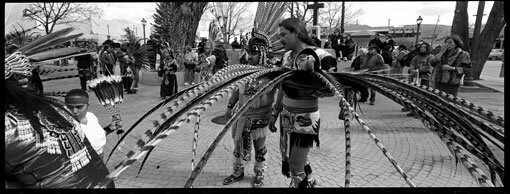 |
|
|---|---|
|
|
__Spanish colonists established their first ranchos in the valley in the 1600s, and permanent settlement commenced in 1776 with a fortified plaza at nearby Ranchos de Taos. Although records for Taos are fragmentary, it, too, likely began as a fortified plaza constructed about 1796. The flat-roofed, one-room-deep houses of the settlers, standing shoulder to shoulder, created a defensible enclosure. The village received a license to erect a church in 1801, and the chapel of Our Lady of Guadalupe, located west of the plaza, first appears in colonial documents in 1815. __Taos prospered as a farming village, a center for the fur trade, and, after 1821, as an alternate terminus of the Santa Fe Trail. Following the American occupation of 1846, local merchant Charles Bent was appointed U.S. territorial governor at Santa Fe. When he returned to visit his family in January 1847, Mexican nationalists along with Taos Pueblo Indians attacked and killed him and six other Americans in and around the plaza. __Hispanic and Anglo merchants added Territorial style portales and even a grand Italianate residence. The railroad arrived in New Mexico in 1879, but never reached Taos because of its mountainous location. As a result, the area changed more slowly than other towns. The first artists found Taos in 1898, and with the founding of the Taos Society of Artists in 1915 it soon boasted one of the best-known art colonies in the country. Their romantic paintings of desert landscapes and Pueblo Indians soon made the town a leading tourist destination. __Following a series of fires around the plaza in the late 1920s and early 1930s, property owners rebuilt in the Spanish Pueblo Revival style, including portales over the sidewalks. Primarily Anglo-American boosters spearheaded the founding of the Taos Fiesta about 1938. Although originally meant for tourists, beginning in the 1960s, control shifted to Hispanic residents, who have reshaped it into an expression of their cultural identity. Further Reading (in addition to The Plazas of New Mexico)
External Links
|


